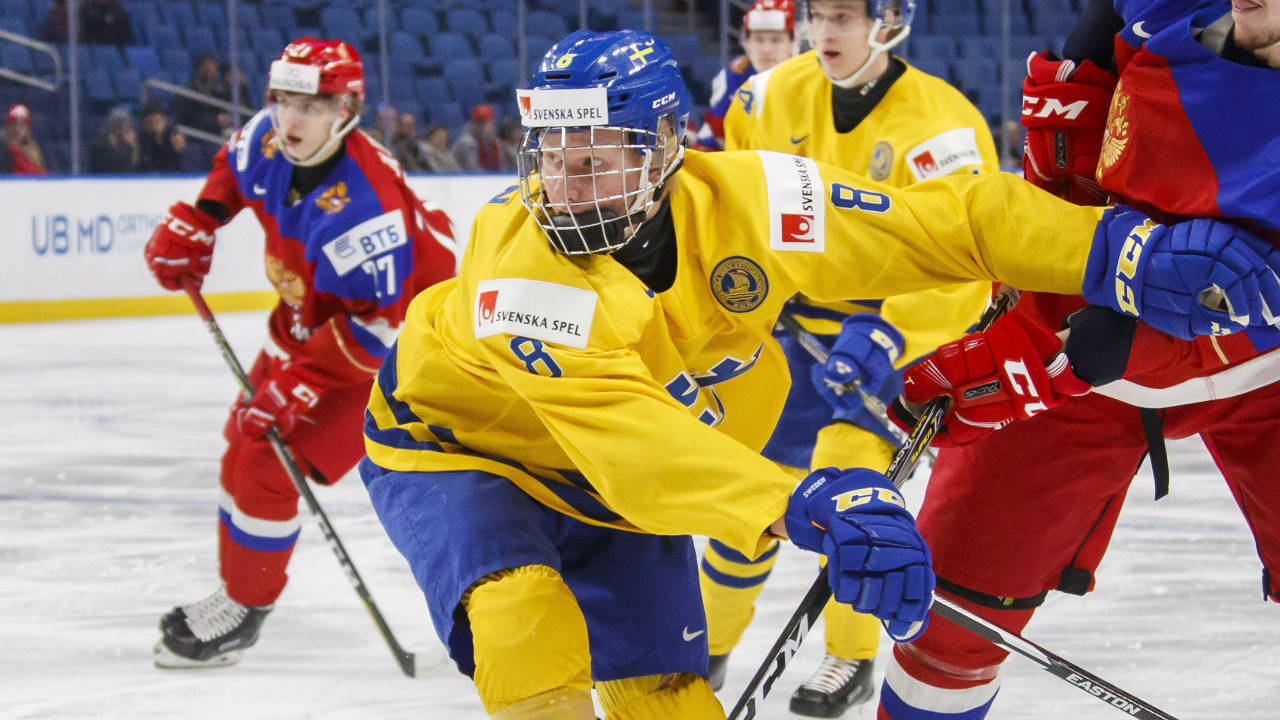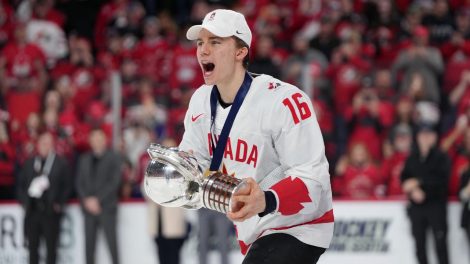BUFFALO – Nothing much was at stake when Sweden faced Russia in the final game of the opening round of the 2018 IIHF world under-20s on New Year’s Eve.
Seeding for the quarters signifies not a heck of a lot — unless you put value in a bronze – but if you’re going to win it all, you’re going to have to beat two good teams the vast majority of the time. Once in a while the stars line up: The middle-rank teams, the Czechs, the Slovaks or the Swiss, will sneak up on one of the heavyweights in the quarters and then, their tournaments feeling complete, become savoury meat in the semis.
Thus, with an 8 p.m. ET start and parties to get to, a lot of people took a pass on what turned out to be the best game of the tournament. I know, you’re saying that this really hasn’t been a memorable tournament so far and it’s true, unless you’re a fan of outdoor games played in a blizzard. Still, given the speed and skill in play, given the back-and-forth action and unpredictability of the final result, Sweden’s 5-4 win over Russia in a shootout would be the best game in a lot of tournaments I’ve attended over the years.
I could have missed it. I’ll admit that I had seriously thought about being some other place on New Year’s Eve. Still, Sweden-Russia was a must-watch for no other reason than it featured the prospects projected to be the first two names called at the 2018 NHL Draft: defenceman Rasmus Dahlin and right-winger Andrei Svechnikov.
[relatedlinks]
The world juniors are hit and miss as a draft tournament for scouts — a very limited number of 17- or just-turned 18-year-olds will be on hand in any given year and they’re known players. Not that it’s never impactful: I’m sure Nico Hischier’s eye-popping performance for Switzerland in last year’s tourney had a lot to do with him moving past Nolan Patrick to the top spot in the draft.
Now, a few have floated the notion that Svechnikov will wind up being the player selected in first overall. I didn’t see it in 2017 nor do I in the opening hours of 2018. Svechnikov didn’t have much of a chance to show his stuff versus Sweden — among his best moments was a sequence in the late going when he displayed some breathtaking speed on a backcheck to run defenceman Erik Brannstrom off the puck. Still, Russian coaches lean on 19-year-olds in the tournament and they’re not above resenting a player who casts his lot in North America like Svechnikov has with the Barrie Colts.
I’m not saying that Dahlin locked up the top slot based on his performance in the game against Russia. Still, he gave something more than glimpses of the talent that will make him an NHL franchise player within two or three seasons. He is that good.
Aesthetically speaking, he’s a perfect skater, textbook, and he has great speed that will only improve at the next level with physical maturity. You can pick that up whenever he steps on the ice.
What we think of routine breakout passes are never quite as routine as we assume but on Dahlin’s stick they are metaphysical certainties. Watching the game down at ice level, I saw him wire a couple of passes right through heavy 5-on-5 traffic that hit tape and I still have no idea how he picked up wingers on the far side of the sheet. And he’s nervy: In the second period Dahlin retreated to pick up a dump-in and picked up a swift Russian bearing down on him in his rearview mirror. Dahlin picked up the puck sure-handedly, spun quickly and fired a 100-foot pass right between the forechecker’s skates — the pass narrowly missed, maybe a couple of feet in front of a Swedish forward for what would have been a 3-on-2 or 2-on-1.
Still, nothing ventured, nothing gained.
On one of his early shifts in the Russians’ end in the first period he absolutely bamboozled and hoodwinked a Russian forward who tried a little too brazenly to dispossess him at the point — Dahlin spun him around clockwise and then counter-clockwise and blew by him.
In any given game, it’s easier for a forward to make a big impression than it is for a defenceman. And in the world junior tournament, it’s easier for a draft-eligible forward to make an impact than it is a defenceman of the same age. Dahlin led all players with eight shots on goal and in some ways that was the least impressive aspect of his game. Centre Lias Andersson told me that Dahlin, his teammate with Frolunda in the Swedish league, “will be a superstar in the world juniors.”
That’s how it looked on New Year’s Eve. Though Toronto first-rounder, Timothy Liljegren, won player of the game honours for a goal and an assist in the win over Russia, he didn’t impress quite so much as Dahlin — on a couple of occasions Liljegren coughed up the puck or misplaced his compass in his own end.
In going undefeated (again) in the opening round, Sweden showed the most puck skill and skating ability in the tournament. Maybe that’s to be expected of a team that had eight players among the first 38 selected in this past year’s draft. And others shone as brightly as Dahlin, foremost among them centre Elias Pettersson, a Vancouver draft choice who, based on his shiniest moments against Russia, might wind up being the best player from the 2017 draft. It goes right down the lineup — after watching him absolutely own the puck and nearly finish the game twice in overtime, I’ll be surprised if Linus Lindstrom, a Calgary fourth-rounder, doesn’t wind up being a top-six NHL forward.
If Sweden wins gold, I’d expect that it will be Pettersson or Dahlin who are the players of tournament, but that’s a big leap. Owning the most skill is great viewing for scouts but it doesn’t necessarily translate into gold — Sweden’s goaltender Filip Gustavsson will have to be better if his team is to hear the anthem after the final. No doubt, though, the Swedes are the most entertaining team in the tournament and in Russia they found a perfect foil.
Their side of the draw was overshadowed by Canada and the defending champs on the other. Coaching staffs for those two teams though got an eyeful last night.








